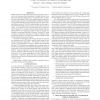Free Online Productivity Tools
i2Speak
i2Symbol
i2OCR
iTex2Img
iWeb2Print
iWeb2Shot
i2Type
iPdf2Split
iPdf2Merge
i2Bopomofo
i2Arabic
i2Style
i2Image
i2PDF
iLatex2Rtf
Sci2ools
ICIP
2010
IEEE
2010
IEEE
Deterministic structured network coding for WWAN video broadcast with cooperative peer-to-peer repair
Recent research has exploited the multi-homing property (one terminal with multiple network interfaces) of modern devices to improve communication performance in wireless networks. Cooperative Peer-to-peer Repair (CPR) is one example where given simultaneous connections to both a Wireless Wide Area Network (WWAN) and an ad-hoc Wireless Local Area Network (WLAN), peers receiving different subsets of WWAN broadcast packets can exchange received WWAN packets with their ad-hoc WLAN peers for local recovery. In our previous work, we have shown that by using Network Coding (NC) to linearly combine received packets into new CPR packets for local exchanges, packet recovery can be improved. Moreover, by imposing Structure on Network Coding (SNC) when encoding a CPR packet, decoding of at least the important packets becomes possible in the event when insufficient number of CPR packets were received for full recovery. Given SNC is used during CPR, the key decision for each peer is to determine w...
| Added | 12 Feb 2011 |
| Updated | 12 Feb 2011 |
| Type | Journal |
| Year | 2010 |
| Where | ICIP |
| Authors | Xin Liu, Gene Cheung, Chen-Nee Chuah |
Comments (0)

